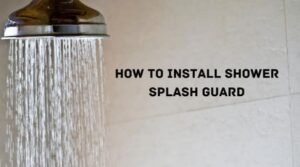Installing a shower splash guard is an easy way to add an extra layer of protection between you and water damage. By keeping water contained within the shower, you can help prevent flooding, mold growth, and other structural problems that could arise from water seeping outside the shower area. If you’re looking to install a shower splash guard in your bathroom, here’s what you need to know.

Measure Your Shower Area
The first step in installing a shower splash guard is to measure your shower area. This will help ensure that your splash guard fits properly and will also give you an idea of how many panels or tiles you need for installation. When measuring your space, make sure to take into account any protrusions such as soap dishes or grab bars, as these may affect the size of the splash guard that you purchase.
Clean Your Shower Walls
Once you’ve measured your space, it’s time to clean your walls. You want to make sure that any dirt or debris is removed so that the splash guard adheres properly and looks its best when installed. A soft sponge and some non-abrasive cleaner should do the trick for most materials; however, if you have tile walls, it might be a good idea to use a more powerful grout cleaner for tougher stains.
Read Also : Top 10 Best Shower Splash Guards Based On Customer Ratings
Install Your Splash Guard
Now it’s time for installation! Depending on the type of material used for your splash guard (i.e., plastic panels, glass tiles), installation methods may vary slightly. However, most require some sort of adhesive or sealant applied around the perimeter of each panel/tile prior to affixing them to the wall surface. It is important to read all instructions thoroughly before beginning this step as improper application can lead to leaks and potential water damage down the line.
Caulk Around Edges
Caulk Around Edges Once all panels/tiles are installed correctly, it’s time for one final step—caulking around all edges where necessary. Sealing up any gaps with caulk helps ensure that no water will escape through small crevices or cracks which could otherwise lead to issues down the line such as mold growth or water damage. Make sure not to skimp on this last step—it’s essential for making sure your shower remains safe and dry after installation!
Conclusion:
Installing a shower splash guard is an easy project that can save homeowners from costly repairs down the line due to water damage caused by splashing showers or baths. By following these four simple steps—measurement, cleaning, installation and caulking—you too can easily add an extra layer of protection between yourself and possible water damage today! With just a few hours of work and preparation, you too can enjoy peace of mind knowing your bathroom is protected from wetness gone wild!